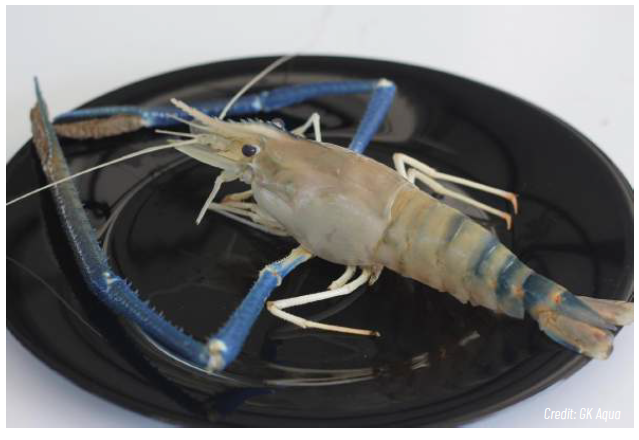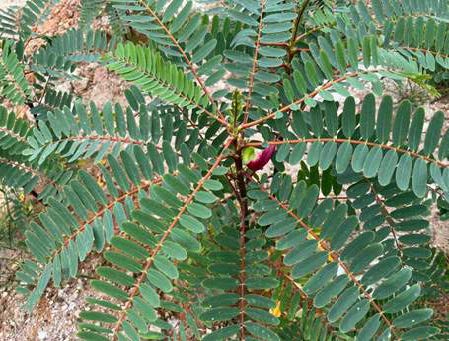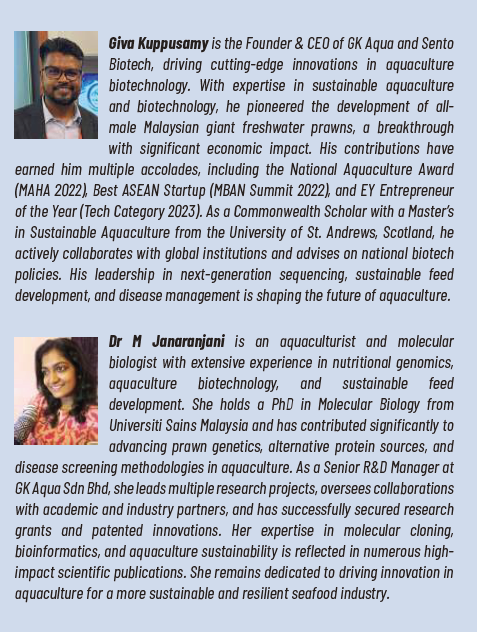Article II 2/2025 - SUSTAINABLE MONOSEX FARMING OF GIANT FRESHWATER PRAWNS IN MALAYSIA: PATHWAY TO A CARBON RESILIENT INSULAR PROTEIN ECONOMY (CRIPE)

Freshwater prawn has been cultured extensively throughout the world with the global production in recent years recorded at 313 756 tonnes and valued at over USD 2.45 billion (FAO, 2023). China is the main producer of giant freshwater prawns, accounting for more than 50% of the global output, followed by Bangladesh, Thailand, Myanmar and India.
Prawn aquaculture production in Malaysia has steadily declined from 752 tonnes in 2001 to 213 tonnes in 2018. This massive reduction could potentially be due to several factors including environmental challenges, disease outbreaks, economic constraints, resource and management issues, and policy and regulatory gaps.
Within the realm of commercial aquaculture, the Department of Fisheries, Malaysia (DOF) has prioritised giant freshwater prawns as a key table food and export commodity. In order to improve seed and juvenile output, the Department has undertaken several initiatives, including the establishment of hatcheries in 1984, but these ultimately did not support commercial success.
Efforts together with the private sector were more successful; by 2013, 23 hatcheries had been established, of which four belonged to the Government. As of 2022, Malaysia’s freshwater prawn hatchery landscape comprised 3–4 largescale facilities, supplemented by numerous smallscale backyard and government-operated hatcheries. However, as seed production predominantly relies on wild broodstock whose populations have been steadily dwindling, the hatcheries have increasingly turned to broodstock sourced from grow-out ponds. About 80% of the brood prawns used by Malaysian hatcheries comes from the wild, with the remaining portion consisting of the largest and healthiest berried females selected from grow-out ponds. Poor quality broodstock can result in inbreeding, leading to low quality seed, which becomes a key obstacle to the growth of this industry.
Monosex breeding enhances survival rates
Monosex culture can be manually performed by segregating male and female prawns based on identifying gonopores through external morphology. However, this method is labour-intensive and can cause significant stress to the prawns. To address these challenges, genetic manipulation techniques such as RNA interference technology, are employed. Malaysian biotechnology company GK Aqua, established in 2016, has pioneered sustainable farming of monosex giant freshwater prawn with the production of consistently high quality all-male monosex prawn seeds, in line with the company’s goal of contributing to Malaysia’s food security while boosting aquaculture profitability.
RNA interference (RNAi) is a biological process where small RNA molecules inhibit the expression of specific genes by degrading messenger RNA (mRNA) or blocking its translation. This process is a natural mechanism for regulating gene expression in cells and has been harnessed as a powerful tool in research and biotechnology. Through the administration of Mr-IAG RNAi, the male post-larvae develop into neo-female prawn that, although still carrying the male chromosome (ZZ), grow into female prawn phenotypically; they can then be included in the natural mating process with male broodstock to produce all-male post-larvae. This technique has been validated by the Malaysian Biosecurity Department (Approved in March, 2018; Ref No: JBK 100-2/1) as a process which produces nongenetically modified (GMO) or living modified organisms (LMO). Through the application of biotechnological methods, the quality of the all-male stock is further enhanced using selective breeding techniques. To support this initiative, GK Aqua established the Nucleus Breeding Centre (NBC) for giant freshwater prawns in an area near the town of Bukit Pelanduk (GPS: 2°39’25” N, 101°44’56” E) as part of its commitment to achieving the nation’s goals.
The primary responsibilities of the NBC include conducting selective breeding for giant freshwater prawns and producing broodstock seed to support the multiplication efforts of accredited local and international institutions, hatcheries, or farmers, including those operated by GK Aqua. The monosex prawn breeding methodology, focused on sex marker validation, has been submitted for patent application (Patent Application No: PI2022006870) and Patent Cooperation Treaty (PCT) registration (International Application No: PCT/MY2024/050007). Beyond commercialisation, GK Aqua conducts continuous research and development to ensure the sustainability and excellence of cultivated species. Key initiatives include nutrigenetic advancements and the production of specific pathogen-free prawns, all aimed at delivering superior-quality prawns.
The carbon-resilient insular protein economy (CRIPE)

Black soldier fly (BSF), scientifically known as Hermetia illucens, is a wasp-like insect from the family Stratiomyidae which is known to be an excellent bio-converter with the capability to transform any kind of organic waste into a useful source of nutrients. The larvae of the black soldier fly (BSFL) can convert over 50% of dry organic matter into highquality feed ingredients. Its use offers numerous benefits, including reducing harmful bacteria during decomposition; providing natural antibiotics that act as growth promoters; eliminating unpleasant odours from waste materials; and modifying the microflora of organic matter. Studies have shown that insect meal can replace 25% to 75% of feed protein for aquaculture species.
Although the BSFL industry is rapidly growing and shows significant promise worldwide, challenges remain. These include a high lipid content (exceeding 25%); the retention of heavy metals such as mercury, chromium, and selenium; and food safety concerns arising from the use of agricultural and domestic wastes in the process, all of which hinder the optimal utilisation of this valuable feed ingredient in animal nutrition.
At GK Aqua’s research facility, an underutilized crop called Sesbania (Sesbania grandiflora) was used as a sustainable and renewable substrate for cultivating black soldier fly (BSF) larvae, efficiently converting biomass into high-quality protein while reducing reliance on marine-derived feed ingredients. Several feeding trials were conducted to determine the optimal percentage of black soldier fly (BSF) insect meal, derived from a Sesbania substrate and marketed as Sento insect meal, in enhancing the growth and fecundity of giant freshwater prawns. The commercial pellets were used as a negative control, while pellets formulated entirely from fishmeal served as a positive control. After three months, post-harvest analysis revealed that up to 75% of Sento insect meal could replace marine protein without compromising prawn survival or growth. The insect meal also contains a high protein level (55%); lower lipid content (less than 10%); and significant amounts of essential amino acids (EAAs); while the presence of heavy metals remains below the detection level.
Additional trials focusing on prawn fecundity demonstrated significant weight gain and a 56% increase in mating success among prawns fed with Sento-formulated pellets compared to those on a commercial diet. The integration of Sesbania, Sento insect meal and monosex prawn breeding exemplifies a transformative approach in building a carbonresilient insular protein economy (CRIPE) in aquaculture. The process not only minimises greenhouse gas emissions and waste but also enhances resource efficiency by upcycling agricultural residues and reducing feedassociated environmental impacts.
The use of Sesbania and the method of preparing thereof has been submitted for patent application, PI2023001409 and subsequently filed under the Patent Cooperation Treaty (PCT) (International application no: PCT/MY2024/050026).
The Malaysian Udang Galah Aquapreneur (MUGA) program

The MUGA program goes beyond mere technical assistance by fostering opportunities for aquaculture entrepreneurship, enabling participants to generate sustainable incomes and elevating their living standards. The program integrates comprehensive training provided by GK Aqua on environmentally sustainable aquaculture practices, emphasising ecosystem conservation, effective water quality management, and biodiversity preservation. This ensures that farming operations are conducted in harmony with nature, mitigating environmental impacts while optimising resource use.
Furthermore, the program adopts a holistic approach to community development by combining innovative aquaculture practices with financial literacy and business management training. Participants are empowered to scale their operations and contribute to a thriving circular economy, aligning with Malaysia’s broader vision of sustainable economic growth. By bridging advanced biotechnology with grassroots implementation, the collaborative efforts of GK Aqua and Sento Biotech through the CRIPE model and MUGA program showcase a scalable model for achieving social, economic, and environmental resilience in aquaculture.
























